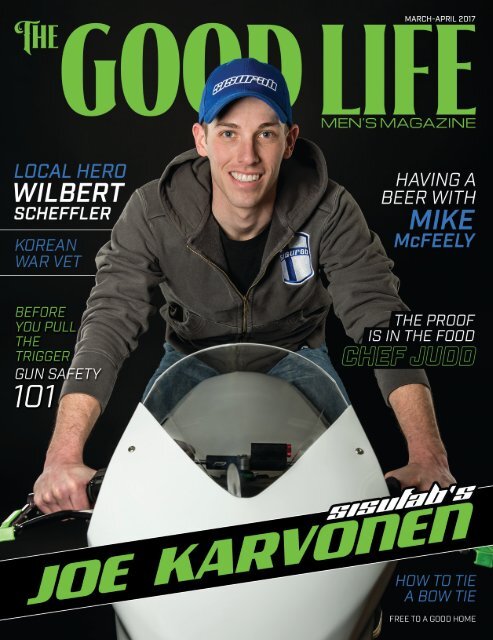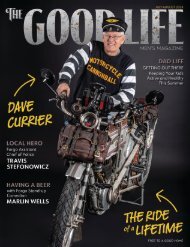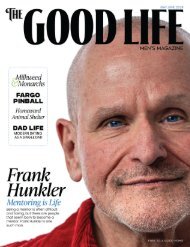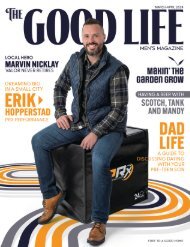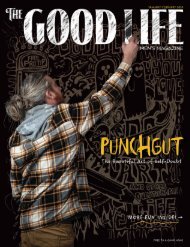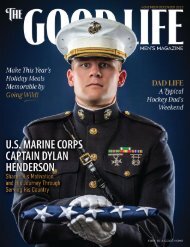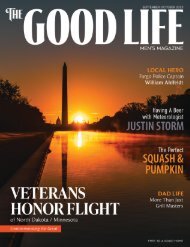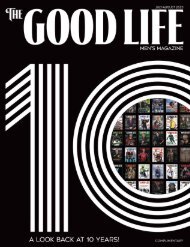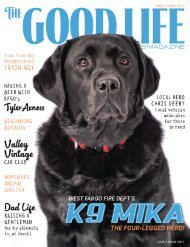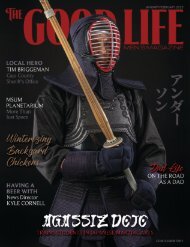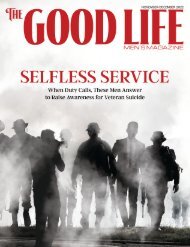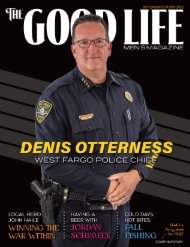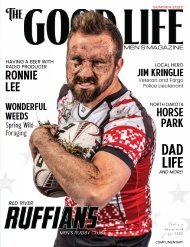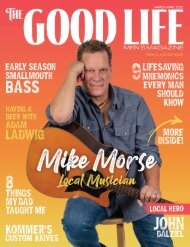The Good Life – March-April 2017
Featuring Joe Karvonen - Motorcycle enthusiast and owner of Sisufab. Local Hero - Korean War Vet, Wilbert Scheffler, Gun Safety 101, How to Tie a Bow Tie and more in Fargo Moorhead's only men's magazine.
Featuring Joe Karvonen - Motorcycle enthusiast and owner of Sisufab. Local Hero - Korean War Vet, Wilbert Scheffler, Gun Safety 101, How to Tie a Bow Tie and more in Fargo Moorhead's only men's magazine.
Create successful ePaper yourself
Turn your PDF publications into a flip-book with our unique Google optimized e-Paper software.
BY: BEN HANSON • MR. FULL-TIME DAD<br />
A few weeks ago, I got accused of being a<br />
helicopter parent. Why? Because I wouldn’t<br />
allow my then 15-month-old son, Macklin,<br />
to run around with a plastic fork in his hand.<br />
I calmly explained to my foresight-deficient<br />
friend that while said fork may be a harmless,<br />
utilitarian eating device to us adults, it’s nothing more than<br />
an unsheathed, medieval eye-poker for an uncoordinated<br />
toddler who only learned to walk two months prior.<br />
It wasn’t helicopter parenting. It was parenting. Parenting<br />
with an eye for potential disasters, and so far Mack still has<br />
two intact eyes, as do all of his playmates. I doubt I’ll ever<br />
receive the thanks I most definitely deserve, but it made<br />
me realize something. If forks are no longer forks, what<br />
else has changed since the introduction of toddlerhood<br />
into my life?<br />
<strong>The</strong> short answer was a lot. Some things have even taken<br />
on new meaning now that we have a walking, handsy<br />
toddler meandering his way through the house. And it’s<br />
not just things. A lifetime of carefully cultivated comfort<br />
is being systematically dismantled under the Mack<br />
Administration.<br />
Ruined Routines<br />
I’ve never lost my car keys. Why? Because I follow a<br />
routine. I always (used to) put them in the same spot—the<br />
left hand pocket of my jacket. Well guess which arm Mack<br />
prefers to ride in to and from the car? My left, which means<br />
there’s no way to both carry him and access my keys. It’s a<br />
real problem.<br />
So just put your keys in your right pocket, you’re thinking.<br />
I guess I have to. I guess my son—whom I love more than<br />
anything, but has only been a part of my life for about<br />
1/17th the amount of time I’ve routinely kept my keys<br />
in my left pocket—now gets to dictate where I store my<br />
personal items. Fine, but now I’m going to have to find<br />
a new place for my wallet, which will undoubtedly force<br />
my phone to find a new home. I just want to know where<br />
it will end. I’m worried this is how fanny packs came into<br />
existence… Oh, you got kids? Here, wear this and forget<br />
you ever had pockets.<br />
Everything Gets Taller<br />
I remember the day we brought home our entertainment<br />
center. Miraculously, it matched the sofa table we already<br />
had in the downstairs living room. Same color wood, same<br />
finish and even the same height. <strong>The</strong> DVD player, receiver,<br />
record player, etc. all looked like they were custom made<br />
for this piece of furniture. I remember thinking we did<br />
it. We completed the basement, and with it, the house.<br />
Everything was perfect.<br />
<strong>The</strong>n we brought Mack home, and that veil of perfection<br />
started to show just how thin it really was. <strong>The</strong> more<br />
mobile Mack became, the more that perfection rubbed<br />
2 / THE GOOD LIFE / urbantoadmedia.com
off our house… and in one specific way. Those<br />
perfectly matching tables have one fatal flaw—<br />
they’re not six feet off the ground. Which is<br />
normal. <strong>The</strong>y’re normal tables. With normal<br />
things on them. For normal people. But<br />
toddlers are not normal people.<br />
As such, the new definition of perfection in<br />
our house is “a realistic expectation to be able<br />
to sit for more than one minute before having<br />
to get up and move something up and out of<br />
Mack’s reach.” You’d think as a stay-at-home<br />
dad who spends most all day playing this game<br />
that eventually I’d win, or at least get a glimpse<br />
of the final move. Nope. Honestly, I think the<br />
only way to win this game would be to move<br />
and start fresh.<br />
Kitchen Dowel Rods<br />
One challenge to the “Raise & Save” game<br />
showed itself early on: shelf space. We do not<br />
have an abundance of shelving in our house, so<br />
we quickly depleted all the easy moves. (Plus,<br />
just because something is out of arm’s reach by<br />
no means makes it out of site, and that game…<br />
let’s just say that game has no winners.)<br />
You also can’t take the entire lower half of<br />
your kitchen and move it up, at least not easily.<br />
Securing the cabinets was simple enough with<br />
your standard kid-proofing gear, but I had to<br />
get a little DIY when it came to the drawers.<br />
One dowel rod placed vertically down through<br />
a row of drawer handles joins them together<br />
into one, child-proof mega-drawer. So along<br />
with essentials like measuring cups, extra<br />
garbage bags and assorted can koozies, you’ll<br />
also find a few dowel rods in our kitchen should<br />
you ever need to… um, dowel something.<br />
<strong>The</strong>y don’t match the rest of our decor in<br />
any way, but they cost $0.98 a piece and do<br />
a fine job of keeping Mack out of my koozie<br />
collection. <strong>The</strong> rods also do a great job of<br />
destroying the finish on the drawers, ensuring<br />
a future kitchen remodel. You’re welcome,<br />
Dear!<br />
A lot has changed in a short amount of time.<br />
I can only imagine what it must be like for<br />
Macklin, for whom everything is not only<br />
changing, but everything is new. It’ll be<br />
a long time before he understands why I<br />
locked up the good filet knives behind a<br />
dowel rod immediately after he discovered<br />
them. But one day, I hope he’ll shake my hand<br />
—with all five fingers—and say thank you. •<br />
urbantoadmedia.com / THE GOOD LIFE / 3
Contents<br />
VOLUME 4 • ISSUE 5<br />
MARCH-APRIL <strong>2017</strong><br />
02<br />
06<br />
10<br />
14<br />
18<br />
24<br />
30<br />
MR. FULL-TIME DAD<br />
EVERYTHING'S AN EYE-POKER<br />
THE CHANGES A TODDLER BRINGS TO YOUR LIFE<br />
CHEF JUDD<br />
MORE THAN A TASTING ROOM • THE PROOF IS IN THE FOOD<br />
HEAD OF THE CLASS<br />
A DAY IN THE LIFE OF 4TH GRADE TEACHER<br />
BRANTON BAARSTAD<br />
HAVING A BEER WITH ...<br />
MIKE McFEELY<br />
ON THE COVER<br />
SISUFAB'S JOE KARVONEN REVS UP<br />
BEFORE YOU PULL THE TRIGGER<br />
THE NEED FOR PROPER GUN PROCEDURES<br />
LOCAL HERO<br />
WILBERT SCHEFFLER - KOREAN WAR VET<br />
4 / THE GOOD LIFE / urbantoadmedia.com
<strong>The</strong><br />
GOODLIFE<br />
MEN’S MAGAZINE<br />
PUBLISHED BY<br />
Urban Toad Media LLP<br />
www.urbantoadmedia.com<br />
OWNER / GRAPHIC DESIGNER<br />
Dawn Siewert<br />
dawn@urbantoadmedia.com<br />
OWNER / PHOTOGRAPHER<br />
Darren Losee<br />
darren@urbantoadmedia.com<br />
CONTRIBUTING WRITERS<br />
Meghan Feir<br />
Brittney <strong>Good</strong>man<br />
Ben Hanson<br />
Krissy Ness<br />
ADVERTISING INQUIRIES<br />
Darren Losee / 701-261-9139<br />
darren@urbantoadmedia.com<br />
READ A PAST ISSUE<br />
issuu.com/<br />
thegoodlifemensmag<br />
LIKE<br />
facebook.com/<br />
thegoodlifemensmagazine<br />
TWEET<br />
@urbantoadmedia<br />
<strong>The</strong> <strong>Good</strong> <strong>Life</strong> Men’s Magazine is distributed six times<br />
a year by Urban Toad Media LLP. Material may not be<br />
reproduced without permission. <strong>The</strong> <strong>Good</strong> <strong>Life</strong> Men’s<br />
Magazine accepts no liability for reader dissatisfaction<br />
arising from content in this publication. <strong>The</strong> opinions<br />
expressed, or advice given, are the views of individual<br />
writers or advertisers and do not necessarily represent<br />
the views or policies of <strong>The</strong> <strong>Good</strong> <strong>Life</strong> Men’s Magazine.<br />
urbantoadmedia.com / THE GOOD LIFE / 5
More Than A Tasting Room • <strong>The</strong> Proof is in the Food<br />
BY: KRISSY NESS • PHOTOS BY: URBAN TOAD MEDIA<br />
Justin “Judd” Eskildsen has been cooking for over fifteen<br />
years and like most cooks he started at the bottom and<br />
worked his way up. With no formal training Eskildsen<br />
has proven he has style and talent in the cooking world.<br />
He began his journey at a young age in his mom’s kitchen.<br />
From there he worked at fast food restaurants and local<br />
restaurant Coaches before working his way to Red<br />
Bear in Moorhead. After taking a ten-year hiatus from<br />
cooking, Eskildsen then spent a year working under Chef<br />
Steve Schulz at <strong>The</strong> Toasted Frog as his Sous-chef. He<br />
mentioned that chef Schulz is his biggest local influence,<br />
“He never really sat down and taught me things, but he<br />
asked questions about dishes our crew would create that<br />
would encourage ideas that I already knew, but didn't put<br />
much importance in.” Eskildsen stated.<br />
<strong>The</strong> Coteau des Prairies Lodge in Havana, ND hired<br />
Eskildsen for his first gig as a stand-aloneChef. He created<br />
a 5-course beer dinner featuring Drekker Brewing Co.<br />
and it was an immediate hit. He has been called back<br />
to do many dinners since then. One of them being the<br />
“Tapas and Cocktails” featuring Proof Artisan Distillers<br />
before being officially hired as Proof’s head Chef. What<br />
an honor it must be to have someone taste your work and<br />
immediately want to hire you as their head Chef!<br />
6 / THE GOOD LIFE / urbantoadmedia.com
“I like to have few good drinks, lots of great food, and too<br />
many laughs with the people who are close to me! FAMILY!<br />
Whether it's my real family, my close friends, my crew or<br />
Joel, John and the Minions... I love those people, and being<br />
able to have a free day with a group of any of those people<br />
is THE definition of <strong>The</strong> <strong>Good</strong> <strong>Life</strong>.”<br />
urbantoadmedia.com / THE GOOD LIFE / 7
“One of my favorite<br />
things since I've started<br />
cooking again, is when<br />
I see my food set in<br />
front of people,<br />
and they immediately<br />
reach for their phones<br />
to take pictures.”<br />
Eskildsen has taken the knowledge<br />
that he acquired on his own and<br />
from those he has worked with<br />
along the way and brought that with<br />
him to Proof Artisan Distillers.<br />
Working beside Eskildsen is his<br />
Sous-chef, Erik Johansen; because<br />
of his help, it is not uncommon<br />
to see Eskildsen roaming around<br />
Proof’s tasting room. “One of<br />
my favorite things since I've<br />
started cooking is when I see my<br />
food set in front of people and<br />
they immediately reach for their<br />
phones to take pictures,” affirmed<br />
Eskildsen. Among all the great<br />
food served at Proof, it is first and<br />
for most a tasting room for spirits,<br />
“It's irresponsible to serve cocktails<br />
without offering food; I created<br />
fairly large portions of appetizers<br />
meant for sharing.” <strong>The</strong> Tapas<br />
menu is meant for 3 or 4 people<br />
to share, but as the menu gained<br />
popularity Eskildsen expanded his<br />
menu to include entrées. When the<br />
people ask, he delivers.<br />
8 / THE GOOD LIFE / urbantoadmedia.com
Every week Eskildsen prepares a special<br />
dish, <strong>The</strong> Chef’s Feature, which is an<br />
entrée he creates on his “days off”. <strong>The</strong>se<br />
dishes usually feature fish of the highest<br />
quality and freshness available. Eskildsen<br />
revealed that working with exotic fish is<br />
one if his favorite dishes to prepare. All<br />
of the fish he prepares is, as I mentioned<br />
before, fresh - like shipped from Hawaii<br />
weekly—fresh! It is important to add<br />
that if you find yourself wanting to try an<br />
entrée but notice an issue with allergies,<br />
speak to your server and Eskildsen will<br />
personally discuss options with you. It<br />
is not often that you find yourself in a<br />
situation where the head Chef will take<br />
time out of his busy night to ensure you<br />
enjoy every part of your meal.<br />
Among all the food and cocktails served,<br />
there is an entire staff at Proof that makes<br />
sure you are taken care of - from servers,<br />
to the mixologists and cooks. Not only<br />
does the food compliment the cocktails,<br />
so do the fine people working there.<br />
<strong>The</strong>ir knowledge on everything, Proof is<br />
nothing short of an experience when you<br />
visit.<br />
<strong>The</strong> journey for Eskildsen has been that<br />
of hard work and dedication. It is truly<br />
exciting eating his food and experiencing<br />
Proof’s tasting room.<br />
If it is amazing cocktails, delicious entrées<br />
or maybe just a couple appetizers you are<br />
looking for - look no further than Proof<br />
Artisan Distillers. You will get the best<br />
downtown Fargo has to offer without<br />
the hustle and bustle of a busy, crowded<br />
restaurant. Keep in mind though; Proof is<br />
not a restaurant but rather a tasting room<br />
and one heck of an experience. •<br />
urbantoadmedia.com / THE GOOD LIFE / 9
BY: BEN HANSON<br />
When given the assignment to profile a local elementary<br />
school teacher, I expected the interview to be a mixture<br />
of guarded cynicism and outright fatigue. Just the thought<br />
of trying to hold the attention of 30 nine-year-olds for six<br />
hours a day makes me tired ... and a bit cranky. But Branton<br />
Baarstad, a third-generation teacher at the beginning of his<br />
career, surprised me.<br />
Halfway through his first year teaching 4th grade at<br />
Roosevelt Elementary School in north Fargo, Baarstad is<br />
neither exhausted nor jaded. Quite the opposite, in fact. His<br />
optimism and excitement about his chosen profession are<br />
as genuine as any parent could hope to find in their child’s<br />
teacher.<br />
“It’s been awesome,” Baarstad said of his first few months<br />
on the job. “My class has been great, the staff is amazing<br />
and so is this community.”<br />
So what’s it really like to teach the 4th grade? Baarstad<br />
filled me in on what his usual day looks like at the head of<br />
the class.<br />
10 / THE GOOD LIFE / urbantoadmedia.com
<strong>Good</strong> <strong>Life</strong>: First off, why 4th grade?<br />
Why not middle school or high school?<br />
Branton Baarstad: Initially, I wanted to<br />
be a music teacher, but halfway through<br />
college I decided I didn’t want to focus<br />
in just one area and wanted to teach all<br />
subjects. So I went to the elementary<br />
level and loved it. From practicums<br />
to time in the classrooms, I realized I<br />
could give back to my students what my<br />
teachers gave to me in the elementary<br />
classroom. It really felt like I was in the<br />
right place.<br />
GL: What do you hope your kids learn<br />
from you?<br />
BB: I try to teach my students that in<br />
life it’s not always about getting the best<br />
grades or the best this or that. It’s about<br />
doing your best and pushing yourself to<br />
your limit. If you do that, nothing will get<br />
in the way of becoming what you want<br />
to be. I want to see my students succeed<br />
every day, becoming better people not<br />
just better students. I also try to show<br />
them that they are not just loved by their<br />
family, but they’re also loved here at<br />
school by the teachers and faculty.<br />
GL: What does a normal day look like<br />
for a guy teaching the 4th grade?<br />
7:00 am<br />
I get up and get ready. My commute only takes<br />
about ten minutes, and I usually get to work<br />
around 8:00. [Baarstad earlier admitted he’s<br />
not a morning person, which might explain<br />
why, despite the short commute and lack of<br />
breakfast, he requires 50 minutes to muster the<br />
wherewithals to get out of bed and into the car.]<br />
8:00ish am<br />
I make coffee in my classroom … I’ve got a Keurig in my<br />
room. [Again, not a morning person.] I have all my stuff<br />
ready to go from the day before [it’s impressive how well<br />
he knows himself], so I just check the kids have what they<br />
need.<br />
8:20 am<br />
<strong>The</strong> bell rings. All teachers stand in the halls to greet their students in the<br />
morning, so I’m out there talking with them as soon as they roll in. Once<br />
they settle in, they start their morning work and get their brains going<br />
for about 15 minutes. I take a lunch count and attendance at that time<br />
and go around to make sure students are working and doing what they’re<br />
supposed to be doing.
8:45 am<br />
We start in with large group reading time for about 20<br />
minutes or so ... maybe a story from a book we read together<br />
or vocabulary or spelling words.<br />
9:00 am<br />
We work on writing for about 45 minutes … we’re working<br />
on personal narratives now, then it’s off to gym or music for<br />
40 minutes. This is my prep time to get ready for the next<br />
part of the day.<br />
10:40 am<br />
I pick up my students and we grab milk and juice on the way<br />
back up to our classroom to start our “dailies” … we rotate<br />
through every 15 minutes for one-on-one time, so every<br />
week I get at least 15 minutes with each student to check in.<br />
12:30 pm<br />
I pick up students at the lunch room and head back up to<br />
classroom for 15-20 minutes of silent reading time. I let<br />
them choose their own book to make sure they enjoy the<br />
reading, then we break into small group and large group<br />
math, for 70-80 minutes.<br />
2:00 pm<br />
We close out the day with either social studies or science.<br />
At 2:45, I have my students write in their planners, clean<br />
up their area and the bell rings at 2:52 and I hand out my<br />
high-fives.<br />
11:50 am<br />
Lunchtime and recess! I take<br />
them down for lunch and then I’ll<br />
usually go to the teachers’ lounge<br />
to see the other teachers and<br />
some parents if they’re there. I sit<br />
and talk and eat lunch …<br />
[I asked what he eats for<br />
lunch, and he said<br />
“some snack<br />
foods.” A dietary<br />
intervention<br />
may be<br />
needed.]<br />
“My class has been great,<br />
the staff is amazing and<br />
so is this community ...<br />
the students have a knack of<br />
knowing ‘hey this guy’s not ready,<br />
we got five minutes to go crazy!”<br />
12 / THE GOOD LIFE / urbantoadmedia.com
3:00 pm<br />
Sometimes I have meetings after school; every<br />
Tuesday and Wednesday I have meetings for sure, and<br />
some Mondays.<br />
AFTER SCHOOL<br />
During the weekdays, I usually go home after<br />
preparing for the next day. I’m not coming in early<br />
to do prep work! I go home and run to train for<br />
Fargo marathon, then it’s Netflix and chill with<br />
my two dogs. It depends on how wired my brain<br />
gets on when I fall asleep. Sometimes it’s 10 p.m.,<br />
sometimes it’s midnight.<br />
<strong>The</strong>re you have it. A day in the life of an elementary<br />
school teacher in Fargo, ND. Not as crazy as you<br />
might expect, but perhaps that’s due to Branton<br />
Baarstad’s enviable professionalism and enthusiasm<br />
for his job. Still, he readily admits he has to keep a<br />
keen eye on his class to avoid a potential derailment.<br />
“You have to be on the ball all the time,” he said.<br />
“If you don’t, the students have a knack of knowing<br />
‘hey this guy’s not ready, we got five minutes to go<br />
crazy!’” •<br />
urbantoadmedia.com / THE GOOD LIFE / 13
14 / THE GOOD LIFE / urbantoadmedia.com<br />
“Living the good life<br />
to me means having<br />
enough time aside<br />
from my job that I<br />
love to have some<br />
free time to relax<br />
with my family, my<br />
dogs and my cats.”
BY: MEGHAN FEIR • PHOTOS BY: URBAN TOAD MEDIA<br />
As the radio announcer of “<strong>The</strong> Mike McFeely Show” on<br />
970 WDAY and a columnist for the “Fargo Forum,” Mike<br />
McFeely has been a recognizable voice in the community<br />
since the ‘90s, soon after he graduated from Moorhead<br />
State (MSUM) in 1989.<br />
On a typical, blustery Tuesday in Fargo, I had the<br />
opportunity to sit down in Drekker Brewing Company<br />
and pick McFeely’s brain about things besides politics,<br />
but President “<strong>The</strong> Donald” still got brought up, so don’t<br />
worry.<br />
<strong>Good</strong> <strong>Life</strong>: Are you nervous for the weird questions that<br />
are about to hit you?<br />
Mike McFeely: Should I be nervous for the weird<br />
questions? I’m in talk radio, so you never know what’s<br />
going to come. It’s usually people, who I often envision<br />
living in their mom’s basement, calling me, so I think I’m<br />
prepared. You don’t live in your mom’s basement, do you?<br />
GL: I actually don’t, though it’s a nice basement. So,<br />
what’s your favorite family tradition?<br />
MM: Well, I’m blushing because I thought it was going to<br />
be all, like, political, weird questions. My favorite family<br />
tradition is going to Itasca State Park in the fall to look<br />
at the leaves. It drives people crazy because they can’t<br />
believe it. I’m the guy who’s always ripping people and<br />
being mean to people on the radio, and I like to go to<br />
Itasca with my wife, daughter and our dogs and look at<br />
the colorful leaves. It’s my favorite day of the year.<br />
GL: If you could meet anyone from the past or present,<br />
who would it be?<br />
MM: Oh, my... Again.<br />
GL: I told you these were going to be tough questions.<br />
MM: I know, but who thinks about these things?<br />
GL: I do.<br />
Darren Losee: Meghan does.<br />
MM: Is this supposed to provide a window into my soul?<br />
GL: Yes.<br />
MM: I would like to meet Donald Trump because that<br />
would be absolutely fascinating. How could you not want<br />
to sit down and absolutely question everything about him,<br />
just to set him off? He clearly has a very thin skin and is<br />
very narcissistic and insecure.<br />
GL: I’d also like to ask him these questions.<br />
GL: What’s your biggest pet peeve—when people call<br />
from their mothers’ basements?<br />
MM: My biggest pet peeve in the world is that people don’t<br />
seem to trust anyone. Facts don’t matter anymore. You<br />
can tell facts to somebody, but if they don’t want to believe<br />
it, they just won’t believe it. <strong>The</strong>y’ll go on the internet and<br />
find other facts that they think are facts, but they’re not<br />
facts, and then they’ll pretend it’s a fact. You can’t reason<br />
with people if they disagree.<br />
GL: Where do you get your facts?<br />
MM: I get my facts from credible news organizations.<br />
As much as people don’t want to believe them or think<br />
it’s all fake news out there, there are still journalistic<br />
urbantoadmedia.com / THE GOOD LIFE / 15
“I would like to meet Donald Trump because that would be absolutely fascinating.”<br />
standards, like the “Washington Post,” “<strong>The</strong> New York<br />
Times,” “Minneapolis Star Tribune,” “LA Times,” “Fargo<br />
Forum”—there’s lots of actual news organizations that<br />
still try to find facts and present them as facts, but people<br />
just don’t want to believe it.<br />
GL: How do you know those are credible sources?<br />
MM: Because they employ real journalists. At some<br />
point, you have to trust institutions. If you don’t trust any<br />
information, unless it’s information you agree with or<br />
that solidifies your viewpoints of the world, how do you<br />
go forward?<br />
GL: How do you decide which journalists are credible<br />
and trustworthy?<br />
MM: Maybe it’s old school, but I believe journalists that<br />
are trained at reputable universities are trustworthy and<br />
at least attempt to be objective. Are any of us always<br />
objective all the time? We all have our biases and see the<br />
world through our eyes, but if you are a trained journalist<br />
and understand the role of a journalist, then I should<br />
trust you.<br />
GL: If two journalists attend the same reputable university<br />
and one of them goes to work at a news organization you<br />
don’t particularly like, would you still trust them?<br />
MM: I would probably lose trust for them if they go to<br />
a Breitbart.com. I don’t believe that’s a credible news<br />
source. It clearly has a slant that goes one direction and<br />
has an agenda or a purpose behind it. If you’re going to go<br />
work for that organization, then can I trust you anymore?<br />
GL: What is something people do that you love and<br />
always catches your attention, like someone opening a<br />
door for another person, or someone giving you a napkin<br />
with a beverage?<br />
MM: I like how people cannot resist petting a dog. When<br />
a dog walks up to somebody, I know it’s a good person<br />
if they instinctively reach down to pet the dog’s back.<br />
Somebody that blanches, ignores, or shoves the dog<br />
away—I have questions about them.<br />
GL: If someone wrote an article about you, what do you<br />
think would be a fitting headline? I don’t get this option<br />
because the headline is always relatively the same.<br />
MM: “He’s not as big of an a**hole as you think he is.”<br />
GL: Whose radio talk show would you want to listen to<br />
more, Batman’s or Superman’s?<br />
16 / THE GOOD LIFE / urbantoadmedia.com
“My biggest pet peeve<br />
in the world is that<br />
people don’t seem<br />
to trust anyone.”<br />
MM: Batman. He’s more of a broody and<br />
introspective guy, and I picture myself<br />
as being broody and introspective,<br />
though I don’t know if that’s how I’m<br />
seen or not, so how could you not want<br />
to listen to a broody and introspective<br />
talk show host?<br />
GL: What’s been your worst date<br />
scenario?<br />
MM: Any date I’ve been on because I’m<br />
a bad dater.<br />
GL: What was the worst and most<br />
uncomfortable one?<br />
MM: Every date I’ve been on. I’m not<br />
kidding. I’m a terrible dater, and I’ll<br />
give you my wife’s phone number and<br />
you can ask her.<br />
GL: So how did that progress? How<br />
did you get a wife?<br />
MM: Alcohol. I’m not joking. God put<br />
alcohol on this earth for bad daters like<br />
me to actually have a shot.<br />
GL: Hah. A shot.<br />
GL: Favorite breakfast food?<br />
MM: Bacon. But I’m trying to not eat<br />
a lot because I’d like to live beyond<br />
the age of 55. I mean, I hope that’s<br />
everybody’s answer. If somebody says<br />
oatmeal, they should be shot.<br />
GL: Chewy or crispy?<br />
MM: Not crispy, but cooked beyond the<br />
point of rawness. Chewy, but not to the<br />
point of crispness.<br />
GL: That’s a very good place to be.<br />
MM: And pre-cooked, microwavable<br />
bacon should be outlawed.<br />
GL: What does living the good life<br />
mean to you?<br />
MM: Living the good life to me means<br />
having enough time aside from my<br />
job that I love to have some free time<br />
to relax with my family, my dogs and<br />
my cats. I don’t have any aspirations<br />
of being wealthy or jet setting across<br />
the world. I just like to spend time with<br />
them, cooking steak on the grill, mixing<br />
a drink and relaxing with the dogs in<br />
the backyard. I’m a simple man. •<br />
urbantoadmedia.com / THE GOOD LIFE / 17
BY: BRITTNEY GOODMAN • PHOTOS BY: URBAN TOAD MEDIA<br />
Joe said he has “always” been into power sports<br />
and motorcycle racing, since childhood. And now, he<br />
added: “I’ve had the luxury and misfortune of turning<br />
my hobby into my job. It’s both the best thing and the<br />
worst thing in the world.”<br />
Joe wants to keep the excitement in power sports and motorcycles: “<strong>The</strong>y’re toys. I<br />
work in an industry of ‘big people toys.’ So many of us still tap into our youth mentality<br />
of wanting to have that toy ... And I am the same way. I still get excitement out of it.” He<br />
especially likes getting other people into these sports as a hobby: “My job is fulfilling because I can<br />
see the passion growing in someone else.”<br />
18 / THE GOOD LIFE / urbantoadmedia.com
“I work in an industry of ‘big people toys.’ So many of us still tap into our youth<br />
mentality of wanting to have that toy ... And I am the same way.<br />
I still get excitement out of it.”<br />
Joe, 28 years old, started Sisufab in 2013, building his<br />
own shop in West Fargo, after a lifetime of motorcycle<br />
and power sports devotion, education, and also paying his<br />
professional dues. In addition to attending the Motorcycle<br />
Mechanics Institute, specializing in Harley-Davidson early<br />
and late models and Honda Hontech, he also has Harley-<br />
Davidson dealership experience and factory training,<br />
Triumph Motorcycle technician training, and extensive<br />
training and experience with Indian Motorcycles.<br />
Beginning with riding a dirt bike as a kid, Joe went on<br />
to work for an Arctic Cat ATV dealer as an adolescent<br />
and then worked at Ma’s Cycles in West Fargo during<br />
High School. Attending what Joe called West Fargo High<br />
School’s “excellent recreational engines program,” he<br />
is a two-time state winner in the Skills USA Motorcycle<br />
Service Technology program. Skills USA promotes<br />
vocational competitions for high school and college<br />
students across the United States. During his junior year<br />
he placed third nationally and in his senior year he won<br />
first place in the national competition, which also landed<br />
him a scholarship to the Universal Technical Institute<br />
– Motorcycle Mechanics Institute (MMI) in Phoenix,<br />
Arizona.
After college at MMI, Joe worked for the local Harley-<br />
Davidson dealership and then also what is now Legendary<br />
Motor Sports (formerly Indian Triumph of Fargo).<br />
In 2013, Joe explained, “I thought I was going to get out<br />
of the motorcycle industry, but that didn’t happen.” While<br />
he was working in electric motor sales and service for<br />
a friend’s company, he built a small shop in West Fargo<br />
solely to work on motorcycles on the side, “and after a<br />
little while work came to me, and it really took off, and<br />
now we are where we are today.”<br />
Joe gives a great deal of credit to what he gained through<br />
20 / THE GOOD LIFE / urbantoadmedia.com<br />
Skills USA and West Fargo’s programs: “Those pinnacle<br />
game changing points steered me in the right direction<br />
to go to college. Both of these programs are ones that I<br />
do not want to see go away as they are huge assets to this<br />
industry” and provide opportunities for young people.<br />
Currently, one would describe Sisufab as “very busy.” Joe<br />
smilingly said, “<strong>The</strong>re’s no lack of stuff to do.”<br />
“Since we’re a smaller shop – there is constantly a<br />
struggle in balancing how much work one can do,” Joe<br />
explained. But he added, “It’s not a bad problem to have.”<br />
He described the local motorcycle culture as “strong:” “It
is better than it was in the early 2000s and it is also more<br />
diverse – we work with every kind of brand.” Although Joe<br />
described that a heavy part of their business is working<br />
on cruisers, such as Harley-Davidson and Indian, his shop<br />
also “branches away from that too.” Looking around the<br />
shop, there is often exotic motorcycles, like Ducati and<br />
<strong>April</strong>ia, mixed in with more common foreign motorcycles,<br />
like Honda and Kawasaki.<br />
Something new for Sisufab has been becoming the sole<br />
US distributor for the German motorcycle company,<br />
Krämer Motorcycles, specializing in road racing<br />
machines. Joe described this as exciting but also as a<br />
challenge, as it was more work than anticipated: “We<br />
are technically the US end of the company and the sole<br />
distributor. It’s been a good thing but a daunting task. It<br />
is fun and it also opens us up to the nationwide market.”<br />
<strong>The</strong> name of his company, Sisufab comes from the<br />
Finnish word “sisu” which means “courage, resilience<br />
and determination” and “fab” for “fabrication.”<br />
Joe lives with his girlfriend of six years, Brittany Taplin,<br />
who in addition to her work with a local architecture firm,<br />
helps out Sisufab with graphics, web site, computer work<br />
and in organizing and facilitating special events. Joe said<br />
urbantoadmedia.com / THE GOOD LIFE / 21
“I find myself concentrating more on making other people happy<br />
than on anything else. Making money is just a byproduct. If you<br />
concentrate on making money, you aren’t very happy.”<br />
that Brittany is also into power sports and has plans to<br />
explore road racing this year.<br />
In their spare time, Joe and Brittany love to go ice racing:<br />
“We put studded tires on our dirt bikes, haul them to a<br />
friend’s lake place, plow a track on the ice, and go ride.”<br />
Joe also enjoys non-motorized recreation, of the bicycle<br />
kind, as a way to keep in shape and relax.<br />
What’s on the horizon for Joe and Sisufab? First off, he<br />
is helping to organize an indoor motorcycle flat track<br />
race at the Schollander Pavilion at the West Fargo<br />
Fairground this <strong>April</strong> 29th. Flat track racing is highly<br />
competitive and fast-paced and is also sometimes<br />
22 / THE GOOD LIFE / urbantoadmedia.com<br />
referred to as “dirt track” racing. <strong>The</strong> last time flat<br />
track racing happened in West Fargo was in the 1980s.<br />
Joe is hoping this event will help spark excitement for<br />
motorcycle racing in this community again.<br />
For his business, Joe said, “Our future goal at this point<br />
– our achievable goal – is to try to find a new building<br />
to grow our business in size physically. Our shop is new,<br />
but it is small. We keep it tidy and clean but it is too little<br />
for what I have on a day to day basis.”<br />
Joe looked forward: “We have the hopes of expanding<br />
into doing more of a dealership set up, but not on a<br />
big scale. We have a strong market here. I am pretty
confident in the future that we will continue to grow at a<br />
steady and manageable pace.”<br />
When asked “What does <strong>The</strong> <strong>Good</strong> <strong>Life</strong> mean to you?”<br />
he explained: “To me, ‘the good life,’ is to be able to<br />
enjoy what I do on a day to day basis – through my<br />
business, being able to enjoy what I do with power<br />
sports and motorcycles and to help other people with<br />
the same thing. It makes my life enjoyable. It is a reason<br />
to get up in the morning and go to work. I find myself<br />
concentrating more on making other people happy than<br />
on anything else. Making money is just a byproduct.<br />
If you concentrate on making money, you aren’t very<br />
happy.” •<br />
urbantoadmedia.com / THE GOOD LIFE / 23
24 / THE GOOD LIFE / urbantoadmedia.com
Ready. Aim. Fire. Actually, wait.<br />
<strong>The</strong>re is a lot more to shooting a<br />
gun than just pulling the trigger and<br />
looking like you just stepped off the set<br />
of “Duck Dynasty” or “Lethal Weapon”<br />
(one, two, three or four).<br />
As a woman who has never worn pink<br />
camo and has not hunted much of<br />
anything, besides deals on clearance<br />
racks, my experience with guns is<br />
solely comprised of one game of Annie<br />
Oakley with a rifle and a handful of<br />
clay pigeons in a forsaken field.<br />
To familiarize myself with the basics,<br />
Brent Brattlof, the general manager at<br />
Bill’s Gun Shop and Range in Fargo<br />
and Moorhead, graciously taught me<br />
a few pointers about gun handling<br />
and safety. Every current and potential<br />
firearm owner should practice<br />
the steps mentioned in this article<br />
faithfully.<br />
To put the lesson into action, I was<br />
allowed to carefully use a 9mm<br />
handgun in the range, which was an<br />
exhilarating experience. I just wish<br />
I had been wearing my prescription<br />
glasses.<br />
Before you buy<br />
Whether you are a collector, a hunter,<br />
a safety activist or a combination of<br />
all three, it’s important to know the<br />
purpose behind the purchase before<br />
making your final selection.<br />
“You have to have a knowledge of<br />
the firearm to know what you want,”<br />
Brattlof said. “<strong>The</strong>re should be intent<br />
behind every purchase.”<br />
<strong>The</strong> staff at Bill’s Gun Shop and Range<br />
not only helps customers choose the<br />
right gun for their specific situations,<br />
they give in-depth training, illustrate<br />
how to take apart a firearm<br />
for field tripping and cleaning,<br />
offer classes, and sell safety<br />
equipment and safes for<br />
secure storage.<br />
Guns in the home<br />
As is the case with numerous<br />
Midwestern residents, Brattlof<br />
grew up in an environment<br />
where hunting meant spending<br />
some quality time with his<br />
father.<br />
“I probably started shooting when I<br />
was 8 with just a little .22 bolt-action<br />
rifle,” Brattlof said. “It just kind of<br />
progressed as I got older into hunting<br />
long guns, and I bought my first<br />
handgun when I was 22.”<br />
Every responsible gun owner knows<br />
that education begins in the home.<br />
In order to prevent accidents and the<br />
mishandling of weapons, parents need<br />
to educate their children about the<br />
proper treatment, power and potential<br />
dangers of weapons.<br />
“In my house, they stayed locked up<br />
in a safe. I didn’t even know where<br />
the key was until I was 16. I had zero<br />
access to the firearms, unless my dad<br />
was involved. Once I turned 16, I knew<br />
where the guns were, just in case I<br />
would need access to be able to<br />
protect or defend myself.”<br />
Although the risks of<br />
owning precarious<br />
weapons are real<br />
and must be<br />
taken seriously,<br />
the chance of<br />
accidents and<br />
incidents occurring<br />
can be greatly<br />
reduced with<br />
proper training.<br />
BY: MEGHAN FEIR • PHOTOS BY: URBAN TOAD MEDIA<br />
urbantoadmedia.com / THE GOOD LIFE / 25
As shooting becomes more of a sport, this<br />
type of education can be taught in entertaining<br />
ways, whether your child is participating in<br />
trap leagues or going to the range with your<br />
supervision and companionship.<br />
If you are going to carry a gun, you need to<br />
know how to correctly handle it.<br />
1. Never point a gun at someone<br />
“Always keep it in a direction where you know<br />
that if it goes off, it’s not going to hurt anybody<br />
or go where somebody could potentially be<br />
hurt.”<br />
2. Act as though the gun is<br />
loaded<br />
“Never underestimate the power of a firearm,<br />
and never underestimate the person handing<br />
you the gun. You don’t know if somebody<br />
keeps it loaded or not. When you pick it up,<br />
always treat it like it’s loaded. Keep the gun<br />
pointed down, clear the chamber to make<br />
sure it isn’t loaded, and even double check to<br />
make sure you didn’t miss something.”<br />
3. Don’t get too friendly with<br />
the trigger<br />
“Never have your finger on the trigger until<br />
you’re ready to shoot.”<br />
4. Hold the gun firmly in your<br />
hand<br />
“Make sure you have a firm grip so the recoil<br />
doesn’t force the gun from your hand.”<br />
5. Point in a safe direction<br />
“Make sure it’s pointed in a safe direction<br />
before you fire, and always know what’s<br />
behind your target as well, especially for deer<br />
hunting.”<br />
6. Store ammo separately from<br />
the firearm<br />
“When we transport firearms, the ammo and<br />
the guns are never in the same case. <strong>The</strong>y’re<br />
always separated.”<br />
26 / THE GOOD LIFE / urbantoadmedia.com
7. Communicate and store your<br />
firearms in a safe place<br />
“<strong>The</strong>re’s sometimes a lack of communication as<br />
far as what needs to happen after the purchase.<br />
If you take the gun home in the case that you<br />
got, make sure to move it to a safe or secure<br />
location.”<br />
Bill’s Gun Shop has six locations (five that<br />
have ranges) in North Dakota, Minnesota and<br />
Wisconsin. <strong>The</strong>y host special nights for youth,<br />
ladies, and college students at discounted rates.<br />
See their ad on the back page for more info. •<br />
urbantoadmedia.com / THE GOOD LIFE / 27
HOW TO TIE A BOW TIE<br />
IN 7 EASY STEPS (maybe 8 or 9)<br />
STEP ONE<br />
Begin with the bow tie facing<br />
up with the left side (A) slightly<br />
longer than the right side (B)<br />
and cross A over B.<br />
STEP TWO<br />
Bring A under B<br />
and bring up through the loop.<br />
(Throw it over your shoulder to<br />
get it out of the way.)<br />
STEP THREE<br />
Form a bow shape with B by<br />
folding the crease to the right<br />
and then folding to the left.<br />
(Don’t let go!)<br />
STEP FOUR<br />
Bring A over and down the<br />
middle of bow shape created<br />
in step 3.<br />
STEP FIVE<br />
Fold A into a second bow<br />
shape and hold.<br />
STEP SIX<br />
Push the new bow A through the<br />
loop behind bow B. Make sure<br />
folded ‘bows’ are on opposite<br />
sides of the tie.<br />
STEP SEVEN STEP EIGHT STEP NINE<br />
Tighten by pulling the<br />
folded sides of the bow.<br />
Adjust bows evenly.<br />
28 / THE GOOD LIFE / urbantoadmedia.com<br />
See step 1. Start process over<br />
because you are frustrated and<br />
not happy with your<br />
first attempt.<br />
Optional. Take a selfie and post<br />
it online because you are proud<br />
that you accomplished such a<br />
grown-up task.
RETHINK AQUAVIT: TRY IT IN A COCKTAIL<br />
Aquavit is starting to make a splash in the states.<br />
Not only for toasting or special occasions, our VänSkap<br />
Aquavit can be enjoyed alone or in a cocktail.<br />
PHOTO BY: URBAN TOAD MEDIA<br />
HISTORY:<br />
Aquavit is a<br />
flavored spirit that<br />
has been produced<br />
in Scandinavia since<br />
the 15th century.<br />
To honor our deeply<br />
rooted Scandinavian<br />
heritage, we bring<br />
you our VänSkap<br />
(Swedish for<br />
friendship) Aquavit.<br />
FRIENDSHIP COCKTAIL<br />
• 2 oz MINIONS VänSkap Aquavit<br />
• 1 Teaspoon Honey<br />
• 2-4 Dashes Orange Bitters<br />
Pour all ingredients over ice.<br />
Stir for 30 seconds. Strain into<br />
a martini glass or cocktail coup.<br />
Garnish with braided orange.<br />
TASTING NOTES:<br />
Sweet notes of<br />
citrus, fennel,<br />
and star anise are<br />
balanced with spicy<br />
notes of caraway,<br />
coriander, juniper and<br />
a slight hint of dill.<br />
HOW TO ENJOY:<br />
Aquavit can be<br />
enjoyed chilled<br />
in a small glass or<br />
provide a unique<br />
twist in a traditional<br />
cocktail. To friends<br />
new and old, we raise<br />
our glass and say<br />
"VänSkap".<br />
RECIPE:<br />
Try this simple and<br />
tasty recipe you can<br />
make at home.<br />
www.proofdistillers.com<br />
urbantoadmedia.com / THE GOOD LIFE / 29
BY: BRITTNEY GOODMAN • PHOTOS BY: URBAN TOAD MEDIA<br />
87 year old Barnesville native, Corporal Wilbert Scheffler<br />
of the US Army 7th Infantry during the Korean War, is<br />
a local hero worth getting to know. This reflective and<br />
grateful farmer and television repairman’s life was greatly<br />
influenced by his time in service in Korea.<br />
Wilbert is the recipient of many honors for his time in<br />
service, including the Bronze Star, Korean Service<br />
Medal, <strong>Good</strong> Conduct Medal, United Nations Service<br />
Medal, Combat Infantry Badge and the National Defense<br />
Service Medal.<br />
He entered Basic Training in 1952 at Camp Breckenridge,<br />
Kentucky. Wilbert described his fellow soldiers as “all<br />
farm kids, all the same people like I am.” After basic<br />
training, Wilbert said that where the soldier was assigned<br />
was “alphabetical”: “If your last name began near the<br />
beginning, you went to Germany. Mine was later, so I<br />
went to Korea. That’s that.”<br />
During his time in Korea, one of his duties was guarding<br />
a prisoner of war camp. Wilbert explained, “We spent two<br />
years guarding prisoners. Years later we learned it was<br />
a leper colony.” He did not end up with leprosy. Wilbert<br />
was also struck by the poverty of the Korean people,<br />
especially the children: “What really got me over there<br />
were those little orphan kids — they were starving. How<br />
they survived I don’t know. Many soldiers threw crackers<br />
to them and they fought over them.”<br />
30 / THE GOOD LIFE / urbantoadmedia.com
urbantoadmedia.com / THE GOOD LIFE / 31
He recalled one time early in the time in Korea: “I was<br />
so lucky … I was on the north side of Arsenal Hill – I<br />
moved out in the open so that I could see and I no more<br />
than moved and a mortar round came. I was buried<br />
under the rubble and dirt and I was protected. I was on<br />
guard duty all by myself. I was all alone and it was a bad<br />
place. But I was protected.”<br />
Wilbert was dismayed by the lack of attention paid to<br />
the veterans coming back from the Korean War. With<br />
emotion, he said, “When I came back from Korea, nobody<br />
gave a darn.” But something happened in October 2016<br />
that brought tears of joy to his eyes – he was one of the<br />
32 / THE GOOD LIFE / urbantoadmedia.com
veterans selected to travel to Washington DC on the<br />
WDAY Honor Flight. Wilbert exclaimed, “<strong>The</strong> Honor<br />
Flight was like living in another world! People were<br />
so nice. And after the flight, returning home, seeing<br />
all those people at the airport when we came back,<br />
it got to me.”<br />
During the Honor Flight, Wilbert met many people and saw<br />
much. He described being kindly wheeled around in his<br />
wheelchair by Mike McFeely who took him to the Franklin<br />
Roosevelt Memorial. Wilbert enjoyed his time with Tracy<br />
Briggs, Forum Communications and founder of the Honor<br />
Flight back in 2007: “We got along really well. I could say<br />
anything to her and she understood. She wheeled me to the<br />
Vietnam Wall, the Korean War monument, and the Lincoln<br />
Monument.” Wilbert then got up to get something from<br />
another room and returned to proudly show me the thank<br />
you note he received from Briggs, smiled, and said: “She’s a<br />
nice lady.”<br />
When I asked Wilbert about the movie “Pork Chop Hill” he<br />
said, “It was a good movie. Gregory Peck is very good in it.<br />
But nothing can accurately show what we went through.”<br />
Wilbert says that circumstances and people saved his life while<br />
in Korea. Wilbert asserted, “Other people stepped in and saved<br />
me. I didn’t ask for any favors.”<br />
One of those that stepped in was his best friend at war,<br />
Jim Cunningham, who assigned Wilbert to the Commo<br />
(Communications) Unit because of his knowledge of working<br />
with radios and other devices. Wilbert always had a radio: “I kept<br />
urbantoadmedia.com / THE GOOD LIFE / 33
the<br />
radio<br />
going,<br />
guys loved the<br />
music. It helped us<br />
all. I carried the radio<br />
on my backpack. I made<br />
a case big enough for six<br />
flash light batteries and<br />
made it go 24 hours a day so<br />
that the guys had music. Music<br />
was just a life saver.”<br />
One time Wilbert left his radio at the<br />
prison camp he was guarding. When<br />
he got back to his unit, it was gone, and<br />
he figured it was lost forever. <strong>The</strong>n Jim<br />
Cunningham said, “Did you know they<br />
shipped your radio, it’s in supply?” Wilbert<br />
explained, “Getting that radio back was a<br />
life saver for me. It was a Zenith. It was high<br />
quality.”<br />
Another person whose intervention perhaps saved<br />
Wilbert’s life was the officer who decided to send<br />
him to the rear of the line during the Pork Chop<br />
Hill battle. Wilbert emotionally explained, "My best<br />
friend in the Army, Jim Cunningham, died on that hill.<br />
Somebody was looking out for me."<br />
He described the battle: “<strong>The</strong> last battle – out of the clear<br />
blue sky – I had about 40 points and I was supposed to go<br />
home. <strong>The</strong> guys with that many points went back in the<br />
rear. <strong>The</strong> Chinese hit Pork Chop and they were bound to<br />
take it, they just swarmed into battle. And then, us guys in<br />
the rear, we heard that we were going to counter attack.<br />
<strong>The</strong>y lined us up. So many guys were so afraid, they<br />
just collapsed. <strong>The</strong>y did not even have enough officers<br />
to make a company. We went to Hill 200, and they had<br />
decided to abandon Pork Chop.”<br />
a doctor go out of his way to say ‘stay another day?’ He was<br />
kind of like Alan Alda from M.A.S.H., a young guy. I don’t<br />
know his name. I think he saved my life.”<br />
Coming back from the war, he lived his life as a farmer and<br />
a television repairman on the side: “Back in the stone age, I<br />
fixed everyone’s television.”<br />
Wilbert misses Jim Cunningham and communicates with<br />
a relative of Jim’s via email and letters. After the war he<br />
became friends with fellow veteran, Dick Mosca, who was<br />
an officer in the Navy and a Minnesota highway patrolman<br />
who died a week before the October 2016 WDAY Honor<br />
Flight: “He accepted me for what I was. We would go to<br />
veteran’s funerals together. I really miss him.” A major<br />
reason Wilbert went on the Honor Flight was to honor Dick.<br />
Wilbert has been married to Mary Ann since 1976.<br />
<strong>The</strong>y have two children. <strong>The</strong>ir son, Bill, works in the IT<br />
department at MSUM and who Wilbert encouraged with<br />
computers. His daughter, Peggy, lives in Carrington. She<br />
has given him two grandchildren. Evidence of his pride in<br />
his children and grandchildren are in the many photos in<br />
their Barnesville home. Mary Ann and Wilbert are active in<br />
the Barnesville VFW chapter, where he is a Quartermaster.<br />
Wilbert’s son, Bill said this of his dad: “I think the war affected<br />
him in some pretty profound ways. He values all life and<br />
living and, consequently, none of our family members are<br />
hunters, which is unusual for this area. He often feels guilty<br />
eating meat. We grew up on a farm with pet cats, dogs, a pet<br />
chicken that lived in the house for a while, even a pet calf<br />
that roamed our farm yard at one point that he had to bottle<br />
feed to keep alive. He values home and hearth above all else<br />
and was never much for travel or similar excitement that<br />
most people crave after he returned home. I don’t think any<br />
of us who weren’t there with him can ever fully understand<br />
what he saw and what he went through… As a listener to<br />
his stories, it is hard to process it all, I couldn’t imagine<br />
And finally, there was a doctor at the M.A.S.H unit<br />
where he was recovering from a very bad fever. Wilbert<br />
remembered that the doctor asserted, “Stay another<br />
day. It’s really bad out there.” Wilbert thinks his chances<br />
of survival were greatly increased by that kind doctor:<br />
“My company went into it. It was really bad, but I stayed<br />
another day or two, and was saved.” He asked, “Why did<br />
34 / THE GOOD LIFE / urbantoadmedia.com
living through and surviving it. All he wanted was to be<br />
home and ever since he returned home, it’s where he<br />
wants to be and where he is happiest - surrounded by<br />
everyone and everything he values most.”<br />
Bill continued: “We did not have a lot growing up but<br />
he’d still go the extra mile for friends and people in<br />
the local community by helping them with their TVs<br />
and electronics much like he did maintaining radio for<br />
friends back in Korea. Without realizing it at the time,<br />
I followed in his footsteps by continuing the tradition<br />
and helping people in my community with computers<br />
and still do even today in my free time.”<br />
Bill credits Wilbert for his career in computing after<br />
his dad brought a very early Apple II Plus computer<br />
home one day for Bill: “I hooked it to one of the many<br />
televisions in my bedroom (one of the perks of having<br />
a dad who fixed TVs!) and it was love at first sight for<br />
me when I realized I could program it to do whatever<br />
I wanted.”<br />
When asked about how he keeps all of these memories<br />
clear, Wilbert said, “I eat a lot of blueberries. It keeps<br />
your mind sharp.” He is proud that the only pill he<br />
takes is for high blood pressure.<br />
When asked what he considered “<strong>The</strong> <strong>Good</strong> <strong>Life</strong>,”<br />
Wilbert thought a bit and said, “I don’t know ... After<br />
I got back from the war and I owned a farm and I was<br />
helping people with their machinery and television ...<br />
That to me was a good life. All that I went through in<br />
the war and I was not wounded and I am alive. That is<br />
a good life.” •<br />
urbantoadmedia.com / THE GOOD LIFE / 35


